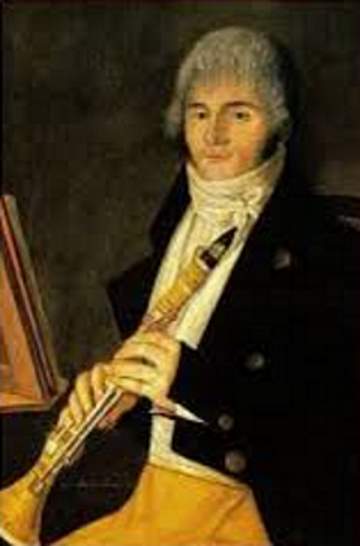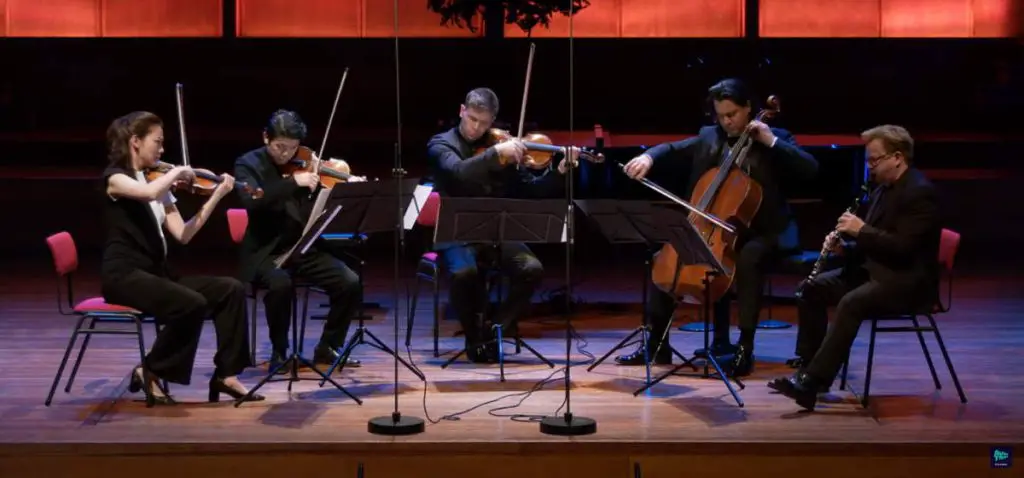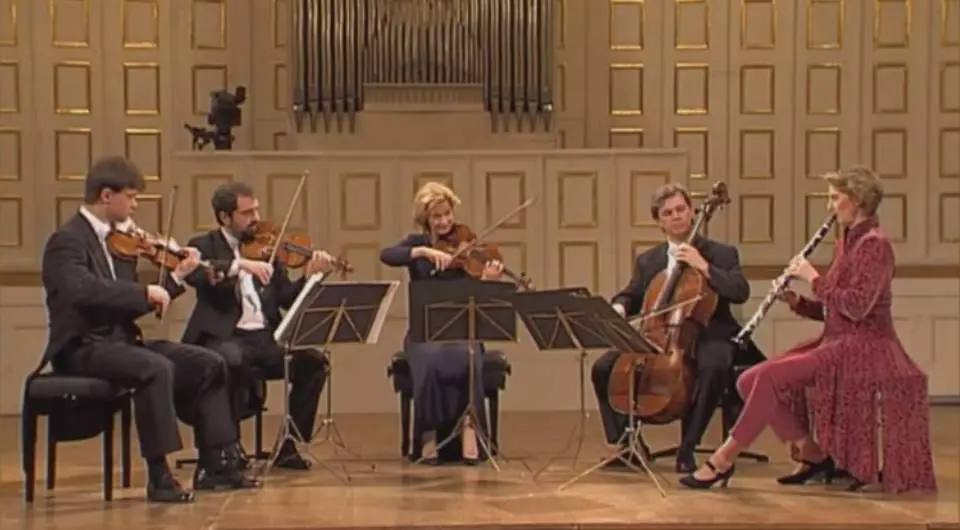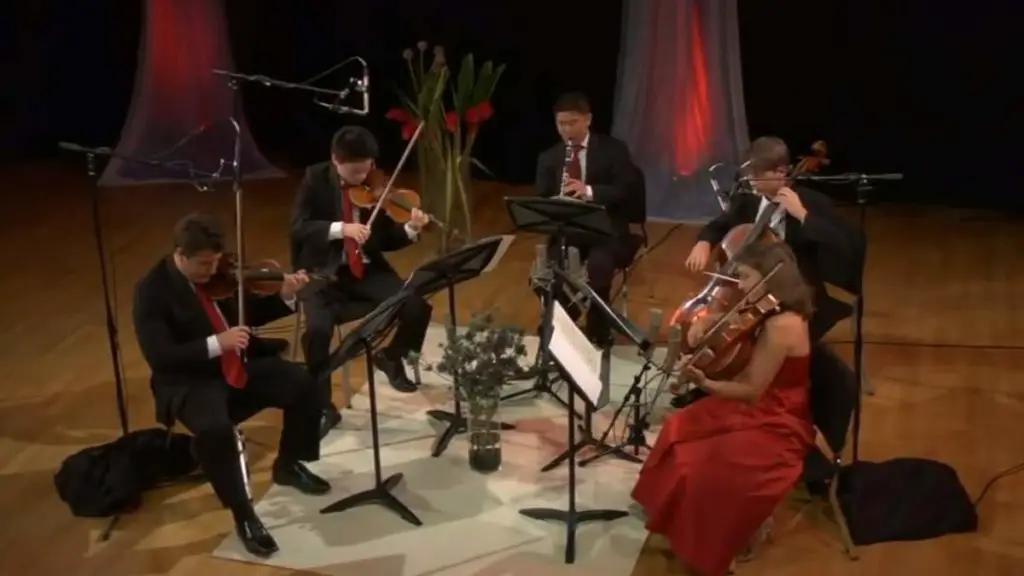Wolfgang Amadeus Mozart’s Clarinet Quintet, K. 581. On Tuesday, December 28, 2021, violist Amihai Grosz and his friends from the Berlin Philharmonic Orchestra (Berliner Philharmoniker) shone in a musical spectacle of the highest level during the Internationaal Kamermuziek Festival (International Chamber Music Festival) Utrecht.
Due to the lockdown, the original program of this edition of the Internationaal Kamermuziek Festival Utrecht (December 27 – December 30, 2021) unfortunately had to be canceled. However, the organizers and musicians did not give up and gave a beautiful concert via a live stream.
A clarinet quintet is a work for one clarinet and a string quartet (2 violins, 1 viola, and 1 cello). Performers:
- Clara-Jumi Kang, violin
- Daishin Kashimoto, violin
- Amihai Grosz, viola
- Claudio Bohorquez, cello
- Wenzel Fuchs, clarinet
Wolfgang Amadeus Mozart’s Clarinet Quintet, K. 581
One of the most admired of Mozart’s works, Clarinet Quintet, K. 581 was written in 1789 for the clarinetist and Mozart’s friend Anton Stadler (28 June 1753, Bruck an der Leitha – 15 June 1812, Vienna). The piece is sometimes referred to as the Stadler Quintet; the composer so described it in a letter of April 1790.
The Clarinet Quintet received its premiere on 22 December 1789 with the solo clarinet part was taken by Stadler.

Movements
The Clarinet Quintet, K. 581 consists of the following four movements:
- Allegro, A major. The first movement of the Clarinet Quintet, K. 581 sets the mood for the entire piece. It has beautiful moving lines in all of the parts and in the second half, there is a virtuoso run that is passed throughout the strings, based on material from the second section of the exposition.
- Larghetto, D major. The second movement opens with a six-bar transition in place of a central development section, which opposes a first section consisting mostly of a clarinet melody over muted strings against a second group of themes in which – as in the first movement – several upward runs of scales are given to the first violin, alternating with brief phrases of clarinet melody. These scales are given to the clarinet in the recapitulation (bar 51). In the last few bars of the movement, more chromatic than the rest, the scales turn into triplet arpeggios traded between the strings under the closing clarinet phrases.
- Menuetto with Trio I in A minor and Trio II in A major. The third movement consists of a minuet and, unusually, two trios. The first trio is for the strings alone, with a theme that has a signature acciaccatura every few notes. The second trio is a clarinet solo over the strings, whereas in the minuet the roles are distributed more evenly.
- Allegretto con variazioni, A major (Variation III in C major) The finale of Mozart’s Clarinet Quintet is in variation form, unexpectedly substituting for the more conventional rondo. The theme is in two repeated halves, with the clarinet joining in but only for a few of its bars. There are five variations:
- The first of its variations gives the clarinet a new theme, in counterpoint with the theme of the variations divided amongst the quartet.
- The second alternates phrases for quartet only with phrases for full quintet, the latter answering the former.
- The third, in A minor, also begins without clarinet, with a viola melody – also with signature acciaccatura – but the clarinet joins into the finish.
- The major mode returns for the fourth variation, as does the main theme to the accompaniment of semiquaver virtuosity – given to the clarinet only in the first repeated half, first violin, and clarinet in the second.
- There are four bars of dramatic interruption leading to a pause; the next variation is a lyrical Adagio. A transition brings us to an Allegro coda, containing much of a variation itself.
Mozart’s Clarinet Quintet, K. 581: Performers

Clara-Jumi Kang
Clara-Jumi Kang (born 10 June 1987 in Mannheim, Germany) is a German classical violinist of South Korean descent. She is known internationally as a virtuoso violinist and a child prodigy. She took up the violin at the age of three and a year later enrolled as the youngest-ever student at the Mannheim Musikhochschuhle.
Having made her concerto debut at the age of five with the Hamburg Symphony Orchestra, Kang has since performed with leading European orchestras including the Leipzig Gewandhaus, Cologne Chamber Orchestra, Kremerata Baltica, Rotterdam Philharmonic, Orchestre National de Belgique, and the Orchestre de la Suisse Romande.
A devoted chamber musician, Kang is a regular visitor to festivals across Asia and Europe.
Daishin Kashimoto
Daishin Kashimoto (born 27 March 1979) is a Japanese classical violinist. Since 2009, he has been the first concertmaster of the Berlin Philharmonic.
Amihai Grosz
Amihai Grosz (born in 1979 in Jerusalem) is an Israeli violist. From 1995 to 2009, he was the violist with the Jerusalem Quartet. Since 2010, Grosz has been the Principal Violist of the Berlin Philharmonic.
He plays a Gaspar-da-Salo viola from the year 1570, which is a lifelong loan made available to him by a private collection.
Claudio Bohórquez
Claudio Bohórquez is a German-born cellist of Peruvian-Uruguayan descent. As a student of Boris Pergamenschikow, He achieved success at an early age at international competitions such as the Tschaikowsky Youth Competition in Moscow and the Rostropovich Cello Competition in Paris.
Bohórquez plays a G. B. Rogeri violoncello presented to him by the Landeskreditbank Baden-Württemberg.
Wenzel Fuchs
Wenzel Fuchs (born 1963 in Innsbruck, Austria) is an Austrian clarinetist. He studied clarinet at the Innsbruck Conservatory with Walter Kefer and at the Vienna Music Academy with Peter Schmidl. He has performed with the Vienna State Opera, the Vienna Philharmonic Orchestra, the Vienna Volksoper, and the Vienna Radio Symphony Orchestra.
Fuchs became clarinet soloist of the Vienna Volksoper at the age of 19 and five years later solo clarinetist of the Vienna Radio Symphony Orchestra, and was appointed solo clarinetist of the Berlin Philharmonic Orchestra in 1993.
Sources
- Clarinet Quintet (Mozart) on Wikipedia
- Clara-Jumi Kang on Wikipedia
- Clara-Jumi Kang official website
- Daishin Kashimoto on Wikipedia
- Amihai Grosz on Wikipedia
- Claudio Bohórquez official website
- Wenzel Fuchs on Wikipedia

